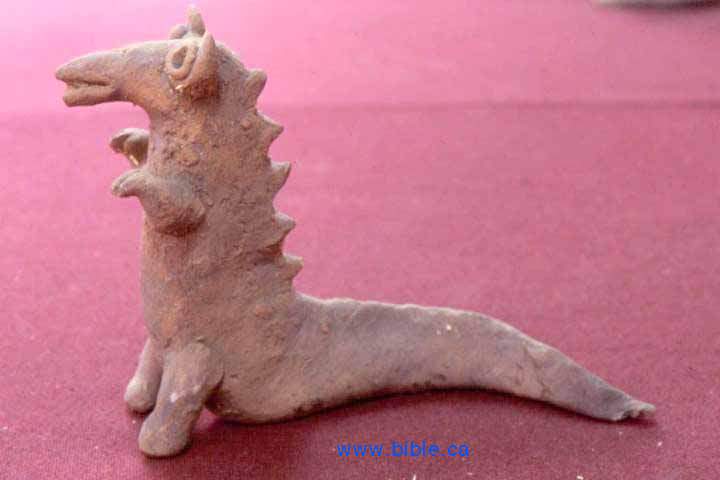Skip to comments.
Details Revealed About Huge Dinosaurs
AP via Yahoo ^
| April 17, 2006
| MALCOLM RITTER
Posted on 04/17/2006 4:56:51 PM PDT by Pharmboy

AP - In an undated photo provided by Professor Rodolfo Coria,
a dog sits by a replica of the head of a Mapusaurus roseae at
the Carmen Funes Museum in Plaza Huincul, Argentina. The dinosaur
was discovered in the Patagonia region of Argentina and
appears to be one of the biggest meat-eating dinosaurs known.
(AP Photo/HO/Prof. Rodolfo Coria)
Scientists are learning more about what appears to be one of the biggest meat-eating dinosaurs known, a two-legged beast whose bones were found several years ago in the fossil-rich Patagonia region of Argentina.
One expert called the discovery the first substantial evidence of group living by large meat-eaters other than tyrannosaurs like T. rex.
The creature, which apparently measured more than 40 feet long, is called Mapusaurus roseae.
The discovery of Mapusaurus included bones from at least seven to nine of the beasts, suggesting the previously unknown animal may have lived and hunted in groups. That hunting strategy might have allowed it to attack even bigger beasts, huge plant-eating dinosaurs.
The find was reported in 2000 by The Associated Press. It is described in the latest issue of the journal Geodiversitas by paleontologists Rodolfo Coria of the Carmen Funes Museum in Plaza Huincul, Argentina, and Philip Currie of the University of Alberta in Canada. They oversaw the excavation of the dinosaur's remains about 15 miles south of Plaza Huincul from 1997 to 2001. Mapusaurus is estimated to have lived about 100 million years ago.
Currie, in an e-mail, said it's hard to say how long the biggest specimen was because no complete skeleton was found. He estimated it may have measured about 41 feet from the snout to the tip of the tail.
It may have been about a foot longer than Giganotosaurus, also found in Patagonia, but without a complete skeleton "you will never know," he wrote.
The Field Museum in Chicago says its T. rex skeleton, Sue, is 42 feet long.
Thomas Holtz Jr., a University of Maryland dinosaur expert, said that Mapusaurus clearly joins Giganotosaurus, T. rex and a huge African beast called Spinosaurus as among the biggest carnivorous dinosaurs. But he said it's impossible to know exactly how they rank in overall size. The fossil record is too fragmentary, and unlikely to capture the biggest individual of each species, he said.
Spinosaurus was probably the longest species, but length is a poor indicator of overall size because tails can be shorter or longer without affecting a creature's weight very much, he said. Still, Spinosaurus was probably the biggest in overall bulk as well, he said.
Coria noted the dig showed evidence of social behavior in Mapusaurus. The excavation found hundreds of bones from several Mapusaurus individuals but none from any other creature. That suggests the animals were together before they died, Coria said.
Perhaps they hunted in packs, though there is no direct evidence for that, he said in an e-mail. Currie, in a statement from his university, speculated that pack hunting may have allowed Mapusaurus to prey on the biggest known dinosaur, Argentinosaurus, a 125-foot-long plant-eater.
Holtz called the finding the first substantive evidence of group living by giant two-legged carnivores other than tyrannosaurs. It's not clear whether the animals cooperated in hunting, as wolves or lions do, or simply mobbed their prey or just gathered around after one of them made a kill, he said.
"Mapusaurus" comes from the word for "Earth" in the language of the Mapuche tribe of western Patagonia, while "roseae" refers both to the rose-colored rock that yielded the specimens and to the name of a sponsor of the excavations.
TOPICS: Extended News; News/Current Events
KEYWORDS: argentina; bigdino; bloodbath; crevolist; dinosaur; dinosaurs; godsgravesglyphs; mapusaurus; meateater; paleontology; philipcurrie; rodolfocoria
Navigation: use the links below to view more comments.
first previous 1-20, 21-34 last
To: Fred Nerks
Take it or leave it. The question remains open. How old are the stones and who created them? It's not an open question, it's pretty obvious they are frauds
Correctly sculpted by ancient peoples. The clay figurine (below right) is from the Pre-classical Chupicuaro Culture (800 B.C. to 200 A.D.) found near Acambaro, Guanajuato, Mexico. It seems obvious these people knew how Iguanodons appeared in life.
umm, no! It doesn't look like an Iguanodon at all. The hands & legs are wrong and it's too thin
Now look at these

Dinosaurs simply could not stand that way, their hips couldn't do it and their backs would have broke
Scientist knew this from the from the first time they found their fossils. Just when mounting them in museums, the museum curators found it easier to mount them upright, and because of this the "Godzilla" stance became ingrained into popular culture pretty much up to the 1st Jurassic Park movie.
So it's pretty clear, that these figurines were faked by someone who clearly got their ideas of dinosaurs from popular culture as opposed to actual people seeing real live dinosaurs in the flesh
21
posted on
04/17/2006 9:18:00 PM PDT
by
qam1
(There's been a huge party. All plates and the bottles are empty, all that's left is the bill to pay)
To: Pharmboy; Fred Nerks
22
posted on
04/17/2006 10:00:12 PM PDT
by
SunkenCiv
(https://secure.freerepublic.com/donate/)
23
posted on
04/17/2006 10:11:06 PM PDT
by
SunkenCiv
(https://secure.freerepublic.com/donate/)
To: SunkenCiv
thanks for the link, looks like the real thingy...
24
posted on
04/17/2006 11:04:13 PM PDT
by
Fred Nerks
(Read the bio THE LIFE OF MUHAMMAD free! Click Fred Nerks for link to my Page.)
To: qam1
They don't look like any artifacts that I've seen pictures of or seen in museums, either. They look rather modern and kind of cartoonish. Most clay figures I've seen are very I guess symbolic? The limbs are straight and blunt, details are cut into the clay and not contoured. These have little fingers, curly tails, and contoured teeth. I would be curious to see how they compare to other artifacts of this time period.
25
posted on
04/18/2006 7:27:54 AM PDT
by
ahayes
To: ahayes
"They look rather modern and kind of cartoonish..."
Interesting comment. That's how I have always viewed them, as caricatures. It strikes me that an artist needs to be very familiar with his subject to create a cartoon representation of a subject. If in fact, the people who created the stones and the figurines lived at close quarters with the creatures depicted, the cartoonish representation may simply tell us how familiar they were with their antics and behaviour.
I am not interested in entering into the Creationism vs Intelligent Design discussion - I just would like to leave the door open to the possibility that these are ancient artifacts...perhaps.
26
posted on
04/18/2006 3:13:01 PM PDT
by
Fred Nerks
(Read the bio THE LIFE OF MUHAMMAD free! Click Fred Nerks for link to my Page.)
To: ahayes

Controversy has raged over the authenticity of the Ica Stones (above) since their discovery in South America. Skeptics have claimed, though without proof, that they are modern forgeries, based on the premise that it is impossible for humans to have seen a living dinosaur. The stones remain a mystery, and reinforce the intriguing possibility that the ancient Amerindians knew of such creatures
27
posted on
04/18/2006 3:18:12 PM PDT
by
Fred Nerks
(Read the bio THE LIFE OF MUHAMMAD free! Click Fred Nerks for link to my Page.)
To: qam1
Darn! Godzilla isn't real?
28
posted on
04/18/2006 3:22:38 PM PDT
by
texasmountainman
(Attention: Single Lady Freepers-I'm not as good as I once was. but I'm as good once as I ever was.)
To: Fred Nerks
It strikes me that an artist needs to be very familiar with his subject to create a cartoon representation of a subject.What, like the depictions in this book?
29
posted on
04/18/2006 3:42:37 PM PDT
by
ahayes
To: Pharmboy
That is one very big munch monster.
30
posted on
04/18/2006 3:44:10 PM PDT
by
R. Scott
(Humanity i love you because when you're hard up you pawn your Intelligence to buy a drink)
To: ahayes
31
posted on
04/18/2006 3:54:00 PM PDT
by
Fred Nerks
(Read the bio THE LIFE OF MUHAMMAD free! Click Fred Nerks for link to my Page.)
To: Fred Nerks
Yes, it's a very good book.
32
posted on
04/18/2006 3:55:56 PM PDT
by
ahayes
To: uglybiker
Nice touch with Mary Jo on the wall too!
Can hardly stop laughing!
Thanks!
33
posted on
04/18/2006 3:56:19 PM PDT
by
nmh
(Intelligent people recognize Intelligent Design (God) !)
This topic was posted , thanks Pharmboy.

34
posted on
12/10/2023 8:33:23 PM PST
by
SunkenCiv
(Putin should skip ahead to where he kills himself in the bunker.)
Navigation: use the links below to view more comments.
first previous 1-20, 21-34 last
Disclaimer:
Opinions posted on Free Republic are those of the individual
posters and do not necessarily represent the opinion of Free Republic or its
management. All materials posted herein are protected by copyright law and the
exemption for fair use of copyrighted works.
FreeRepublic.com is powered by software copyright 2000-2008 John Robinson




